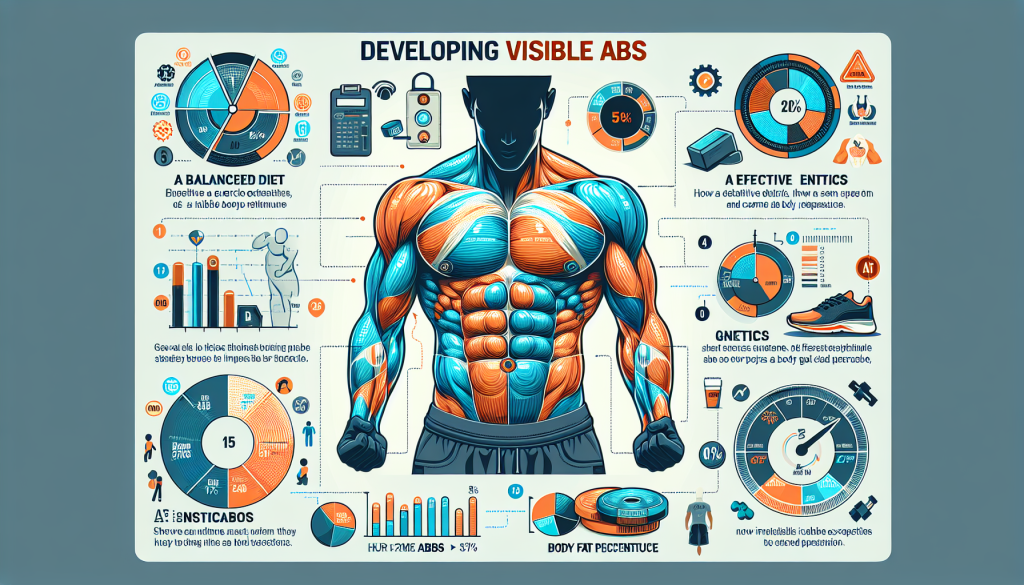Have you ever wondered how long it takes to develop those coveted visible abs? Building a six-pack isn’t just about the aesthetics; it’s also a testament to core strength and discipline. Many people strive for that chiseled midsection, and we’re here to shed some light on the time frame. In this article, we’ll explore the frequently asked question: how long does it usually take to develop visible abs? So, if you’re ready to embark on the journey towards a stronger core and defined abs, buckle up and let’s dive in!

Factors Affecting the Development of Visible Abs
When it comes to developing visible abs, there are several factors that come into play. Let’s take a closer look at each one.
Genetics
Genetics play a significant role in determining the visibility of your abs. Some individuals are genetically predisposed to have more visible abdominal muscles, while others may struggle to achieve the same level of definition. While genetics do play a role, it’s important to remember that everyone can work towards improving their abs regardless of their genetic makeup.
Body Fat Percentage
Body fat percentage is another crucial factor in the development of visible abs. In order for your abs to be visible, you need to have a low body fat percentage. The lower your body fat percentage, the more defined your abdominal muscles will be. For men, a body fat percentage of around 10-12% and for women, around 15-20% is generally considered necessary to achieve visible abs.
Diet and Nutrition
Your diet and nutrition play a pivotal role in developing visible abs. Consuming a balanced diet that is rich in lean protein, fruits, vegetables, and healthy fats can help fuel your muscles and aid in fat loss. It’s important to maintain a caloric deficit, as this will encourage your body to burn stored fat, including the fat covering your abs. Additionally, avoiding processed foods and sugary drinks can help prevent excess fat accumulation.
Exercise Routine
Having a well-rounded exercise routine is essential for developing visible abs. While ab-specific exercises are important, it’s crucial to incorporate a variety of exercises that target different muscle groups. This helps to build overall core strength and stability. Compound exercises such as squats, deadlifts, and push-ups engage your core muscles and help in developing visible abs.
Consistency and Frequency
Consistency and frequency are key when it comes to developing visible abs. It’s important to establish a consistent exercise routine and stick to it. Aim for at least three to four days of exercise per week, focusing on both cardiovascular exercise and strength training. Consistency is what will help you see results over time.
Age
Age can be a factor in the development of visible abs. As we age, our metabolism naturally slows down, making it harder to maintain a low body fat percentage. However, by following a healthy lifestyle and maintaining a consistent exercise routine, it is still possible to achieve visible abs at any age.
Gender
Gender can also impact the visibility of abs. Typically, men have an easier time developing visible abs due to their naturally lower body fat percentages and higher muscle mass. However, this does not mean that women cannot achieve visible abs. With the right approach to nutrition and exercise, women can also develop defined abdominal muscles.
Overall Body Composition
The overall composition of your body, including factors such as muscle mass and body shape, can affect the development of visible abs. Those with a higher muscle mass may find it easier to develop and maintain visible abs due to the increased muscle definition. Additionally, individuals with a naturally more athletic or slender body shape may find it easier to achieve visible abs.
Existing Muscle Mass
Having a good amount of existing muscle mass can contribute to the development of visible abs. Muscle helps to increase metabolism and burn more calories, even at rest. Therefore, individuals with higher muscle mass tend to have lower body fat percentages, making their abs more visible.
Metabolism
Metabolism plays a significant role in the development of visible abs. A faster metabolism helps to burn calories and fat more efficiently, ultimately aiding in achieving a lower body fat percentage. While metabolism is partially determined by genetics, it can also be influenced by factors such as exercise, diet, and overall lifestyle choices.
Understanding the Concept of Visible Abs
Before diving into the details of developing visible abs, it’s important to understand what we mean by the term “visible abs” and how it differs from having strong abs.
Definition of Visible Abs
Visible abs refer to well-defined and clearly visible abdominal muscles. These are the muscles that lie beneath the layer of body fat. When body fat percentage is low enough, the abdominal muscles become more visible, giving the appearance of a toned and sculpted midsection.
Distinguishing Between Visible and Strong Abs
It’s essential to distinguish between visible abs and strong abs. Strong abs refer to the strength and functionality of the abdominal muscles, which play a crucial role in stability, posture, and overall core strength. Visible abs, on the other hand, are primarily focused on aesthetic appearance and require low body fat percentage to become visible.
Role of Body Fat in the Visibility of Abs
The visibility of abs is heavily influenced by body fat percentage. When body fat is high, it covers the abdominal muscles, making them less visible. As body fat percentage decreases, the abdominal muscles become more prominent and defined. Therefore, reducing body fat through a combination of diet, exercise, and lifestyle choices is necessary to achieve visible abs.
Common Misconceptions About Developing Visible Abs
There are several misconceptions surrounding the development of visible abs. Let’s debunk some of the most common ones.
Spot Reduction
One of the most prevalent misconceptions is the idea of spot reduction. Spot reduction refers to the belief that you can target specific areas of your body, such as the abs, and burn fat solely from those areas. However, spot reduction is a myth. The body burns fat as a whole, and you cannot control from which specific areas fat is burned. Therefore, incorporating a well-rounded exercise routine and maintaining a caloric deficit is crucial for overall fat loss, including in the abdominal region.
Magic Pills and Supplements
Another common misconception is the belief in magic pills or supplements that promise to give you visible abs without putting in the work. While certain supplements can support your fitness journey, there is no magic pill that will miraculously give you visible abs. Developing visible abs requires consistent effort, a balanced diet, and a well-planned exercise routine.
Extreme Dieting
Some people believe that extreme dieting or severely restricting their calorie intake will help them achieve visible abs faster. However, extreme dieting is not only unsustainable but can also be detrimental to your health. It’s important to follow a balanced and sustainable diet that provides adequate nutrition and supports overall wellbeing.
Shortcut Programs and Devices
Various shortcut programs and devices claim to provide shortcuts to visible abs with minimal effort. However, the reality is that these programs and devices often overpromise and underdeliver. Developing visible abs requires consistent hard work, dedication, and following a well-rounded fitness routine. Shortcuts rarely yield long-lasting results and can potentially be harmful.
Typical Timelines for Developing Visible Abs
Developing visible abs is not an overnight process. It requires time, effort, and patience. Here’s a look at the typical timelines for developing visible abs.
Initial Progress and Development
During the initial stage of your fitness journey, you may start to notice some progress and development in your abdominal muscles. This can happen within a few weeks of starting a consistent exercise routine and following a balanced diet. During this phase, you may experience an initial reduction in body fat and increased muscle definition.
Short-Term Goals: First Month
In the first month of consistently following a well-rounded fitness routine, including cardiovascular exercise and strength training, you can expect to make noticeable progress. Depending on your starting point, your body fat percentage may decrease, and your abs may become more visible. However, it’s important to remember that individual results may vary.
Mid-Term Goals: Three to Six Months
Within three to six months, you can expect to see significant progress in the development of visible abs. Your body fat percentage will continue to decrease, and your abs will become more defined. At this stage, maintaining consistency and following a balanced diet will be key to sustained progress. However, it’s important to keep in mind that the rate of progress may vary depending on various factors, such as genetics, body composition, and overall lifestyle.
Long-Term Goals: Six Months to One Year
By the six-month mark, you should have significant visible abs. Your body fat percentage will likely be in the range required for visible abs, and your abdominal muscles will be well-defined. This phase requires continued dedication to your fitness routine and maintaining a caloric deficit to support your goals.
Maintenance Phase: Beyond One Year
Beyond one year, the focus shifts from developing visible abs to maintaining them. At this stage, you have reached your goal of visible abs, and the challenge is to sustain them over the long term. Maintaining visible abs requires consistent adherence to a balanced diet, regular exercise, and healthy lifestyle choices.

Tips and Strategies for Developing Visible Abs
Here are some tips and strategies to help you in your journey towards developing visible abs.
Balanced Diet and Caloric Deficit
A balanced diet that provides adequate nutrition while maintaining a caloric deficit is crucial for developing visible abs. Focus on consuming lean protein, fruits, vegetables, and healthy fats while limiting processed foods and sugary drinks. A caloric deficit helps the body burn stored fat, including the fat covering the abdominal muscles.
High-Intensity Interval Training (HIIT)
Incorporating high-intensity interval training (HIIT) into your exercise routine can be highly effective in burning calories and reducing body fat. HIIT involves short bursts of intense exercise followed by brief active recovery periods. This type of workout not only enhances fat burning but also helps to build overall cardiovascular fitness.
Core-Specific Exercises
Engaging in core-specific exercises is essential for developing visible abs. Exercises like planks, crunches, and Russian twists target the abdominal muscles directly and help to build strength and definition. It’s important to incorporate both dynamic and isometric exercises to work all aspects of the core muscles.
Strength Training and Resistance Exercises
Including strength training and resistance exercises in your routine is crucial for achieving visible abs. These types of exercises, such as squats, deadlifts, and push-ups, engage multiple muscle groups, including the core. By developing overall muscle mass, you increase your metabolism and burn more calories, ultimately aiding in reducing overall body fat percentage.
Cardiovascular Exercise
Cardiovascular exercise plays a key role in burning calories and reducing body fat. Activities such as running, cycling, swimming, or even brisk walking can help in achieving a caloric deficit and shedding excess body fat. Aim for at least 150 minutes of moderate-intensity cardio exercise per week or 75 minutes of vigorous-intensity exercise.
Proper Hydration
Staying properly hydrated is important for overall health and can also aid in fat loss. Drinking an adequate amount of water throughout the day helps to support metabolism, maintain energy levels, and minimize water retention. Aim for at least 8 cups (64 ounces) of water per day, or more if you are engaged in intense physical activity.
Adequate Rest and Recovery
Rest and recovery are vital for the development of visible abs. Giving your body time to recover between workouts allows for muscle repair and growth. Aim for at least 7-8 hours of quality sleep each night and incorporate rest days into your exercise routine to prevent overtraining and support long-term progress.
Progressive Overload
Progressive overload refers to gradually increasing the difficulty or intensity of your workouts over time. This can be achieved by adding more weight, increasing repetitions, or reducing rest periods. By continually challenging your muscles, you promote muscle growth and development, leading to improved definition of the abdominal muscles.
Seeking Professional Guidance
If you’re unsure about the best approach to develop visible abs, seeking professional guidance can be beneficial. A certified personal trainer can help create a customized exercise routine and provide guidance on nutrition and goal-setting. They can also ensure proper form and technique during exercises, reducing the risk of injury.
Maintaining Visible Abs
Once you have achieved visible abs, the next step is to maintain them. Here are some tips for sustaining your progress.
Sustainable Diet and Nutrition
Maintaining a sustainable and balanced diet is crucial for keeping visible abs. It’s important to continue consuming a variety of nutrient-dense foods, focusing on lean protein, fruits, vegetables, and healthy fats. Avoid restrictive diets or extreme calorie deficits, as these are not sustainable in the long run and can lead to nutrient deficiencies or unhealthy eating patterns.
Consistency in Exercise Routine
Consistency is key when it comes to maintaining visible abs. Stick to a regular exercise routine that includes a mix of cardiovascular exercise, strength training, and core-specific exercises. Aim for at least three to four days of exercise per week to maintain muscle mass, support a healthy metabolism, and burn calories.
Regular Body Fat Assessments
Monitoring your body fat percentage regularly can help you stay on track and make necessary adjustments to your routine. Several methods, such as skinfold calipers, bioelectrical impedance, or DEXA scans, can be used to assess body fat percentage. By tracking your progress, you can make informed decisions about your diet and exercise routine.
Adjusting and Adapting Fitness Goals
As you progress in your fitness journey, it’s important to periodically reassess your goals and make adjustments as needed. If you have achieved visible abs and are looking for new challenges, consider setting new fitness goals, such as improving strength, endurance, or overall athletic performance. This can help maintain your motivation and prevent complacency.
Lifestyle Changes for Sustained Results
Maintaining visible abs requires long-term lifestyle changes. Focus on creating healthy habits that align with your goals, such as incorporating physical activity into your daily routine, making nutritious food choices, and managing stress levels. By adopting a holistic approach to health and wellness, you can sustain the results you have worked hard to achieve.

Understanding Plateaus and Challenges
During your journey to developing visible abs, you may encounter plateaus and various challenges. Here’s how to navigate through them.
Plateauing Effect
It’s common to experience plateaus during your fitness journey, where progress seems to stall. This can be attributed to various factors, such as metabolic adaptation, decreased muscle responsiveness, or lack of variety in your exercise routine. To overcome plateaus, try changing your workout routine, increasing the intensity, or trying new exercises to continuously challenge your muscles and stimulate progress.
Adapting and Changing Workout Routine
To prevent plateaus and maintain progress, it’s important to continuously adapt and change your workout routine. This can include increasing the difficulty of exercises, incorporating new exercises, changing the order or intensity of your workouts, or trying different training methods such as supersets or circuit training. By keeping your routine fresh and challenging, you can break through plateaus and continue making progress.
Addressing Plateaus with Nutrition
If you find yourself in a plateau, it’s worth assessing your nutrition and making adjustments if necessary. Ensure you are still maintaining a caloric deficit if your goal is to reduce body fat. Keep track of your calorie intake and adjust portion sizes or macronutrient ratios as needed. It may also be beneficial to consult with a registered dietitian or nutritionist to fine-tune your dietary approach.
Mindset and Motivation
Developing visible abs requires a strong mindset and motivation. Remember that progress takes time, and setbacks are a natural part of the journey. Stay focused on your goals and remind yourself of the reasons why you started. Surround yourself with positive influences, whether it be supportive friends and family or joining a community or fitness group that shares similar goals. Celebrating small victories along the way can also help maintain motivation.
Injury and Recovery
Injuries or setbacks can temporarily impede your progress in developing visible abs. It’s important to prioritize your overall health and listen to your body. If you experience pain or discomfort during exercise, take a break and allow yourself time to recover. Modify your workouts as needed and consult with a healthcare professional if necessary. Remember, taking care of your body and allowing for proper recovery ultimately supports sustained progress.
Psychological and Emotional Aspects of Developing Visible Abs
The journey to developing visible abs can have psychological and emotional implications. Here are some aspects to consider.
Body Image and Self-Esteem
Developing visible abs can influence body image and self-esteem. While striving for visible abs is a valid goal, it’s important to foster a positive body image and remember that everyone’s body is unique. Focus on celebrating your progress, regardless of the pace, and develop self-acceptance and self-love throughout your fitness journey.
Managing Expectations
Managing expectations is crucial when it comes to developing visible abs. Remember that progress takes time and results vary from person to person. Set realistic and achievable goals, and understand that the timeline may be different for each individual. Stay committed to your routine and embrace the journey, rather than solely focusing on the end result.
Coping with Setbacks and Challenges
Setbacks and challenges are inevitable in any fitness journey. It’s important to develop healthy coping mechanisms to navigate through these obstacles. Seek support from friends, family, or fitness communities to help you stay motivated and encouraged. Practice mindfulness and self-compassion, allowing yourself grace and patience during challenging times. Remember that setbacks are temporary, and with perseverance, you can overcome them.
Creating a Healthy Relationship with Exercise and Nutrition
Developing visible abs should be part of a holistic approach to health and wellness. Focus on creating a healthy and sustainable relationship with exercise and nutrition. Avoid overly restrictive diets or excessive exercise regimens that can lead to an unhealthy mindset or disordered eating patterns. Instead, embrace a balanced and inclusive approach that supports your overall wellbeing.

Frequently Asked Questions (FAQs)
Can anyone develop visible abs?
Visible abs are achievable for most individuals with dedication, perseverance, and the right approach to diet and exercise. While genetics and individual differences may influence the rate and extent of progress, anyone can work towards developing visible abs by focusing on reducing body fat percentage and building core strength.
How can I determine my body fat percentage?
Body fat percentage can be measured using various methods, including skinfold calipers, bioelectrical impedance, hydrostatic weighing, or DEXA scans. These methods provide an estimate of body fat percentage by measuring factors such as skinfold thickness, conductivity, or body density. Consult a healthcare professional or certified fitness specialist to determine the most suitable method for you.
What is the most effective diet for developing visible abs?
There is no one-size-fits-all answer to the most effective diet for developing visible abs. It’s important to focus on a balanced diet that provides adequate nutrition, supports fat loss, and is sustainable in the long run. Aim for a healthy mix of lean protein, fruits, vegetables, healthy fats, and whole grains. Consult with a registered dietitian or nutritionist who can create a personalized plan based on your individual needs and goals.
Can I develop visible abs without exercising?
While it is possible to achieve a low body fat percentage through strictly controlling your diet, exercising is crucial for developing visible abs. Exercise helps to build muscle mass, increase metabolism, and support overall fat loss. Additionally, a well-rounded exercise routine that incorporates strength training and core-specific exercises is essential for developing and maintaining visible abs.
Are there any shortcuts or quick fixes to get visible abs?
Developing visible abs requires time, effort, and consistency. There are no shortcuts or quick fixes that will give you immediate results. Be wary of programs, devices, or supplements that promise quick results without putting in the work. Remember that sustainable progress comes from a balanced and holistic approach to fitness, nutrition, and overall health.





